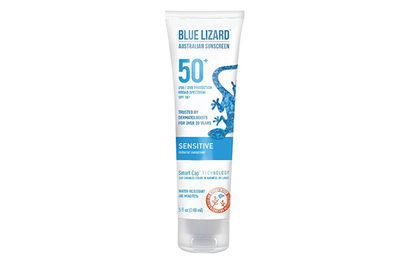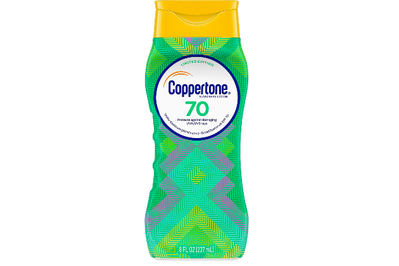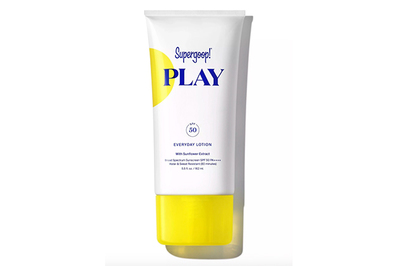Call it the Sunscreen Paradox Factor: You might think a big SPF number on your sunscreen bottle gives you more protection. But it might just be upping your chances of experiencing sun damage.
Using sunscreen with a high SPF (roughly 50 and above) can impart a false sense of invincibility and may lead people to stay in the sun longer without reapplying, which is required to best protect skin from harmful radiation, says the Skin Cancer Foundation. As numerous studies on sunscreen usage have found, no matter what SPF people are using, they routinely apply less sunscreen than needed (whether lotion, spray, or stick) for optimal protection and don’t reapply frequently enough, either.
The single best way to use sunscreen effectively, in fact, is to consider it a supplementary tool in your sun-protection arsenal, which should primarily include seeking out shade as well as using sun hats, sunglasses, rash guards, UPF clothing, and the like. In our guide to the best sunscreens, we describe sunscreen as a “second line of defense”—after sun avoidance. We also note that application amount and frequency matter more than SPF, even recommending that “an SPF 15 lotion that you apply liberally and often can protect you better than an SPF 50–plus lotion that you put on only once in eight hours.” (The American Academy of Dermatology recommends using sunscreens labeled SPF 30 or higher. All of our picks are.)
But what exactly do words such as “liberally” and “often” mean when it comes to sunscreen application? Keep reading for the best strategies to ensure you hit those benchmarks whether you’re applying sunscreen on yourself or your kids, and whether you opt for a lotion, spray, or stick.
Blue Lizard Sensitive Mineral Sunscreen SPF 50+
This physical sunscreen lotion absorbs easily and is free of added fragrance. While this water-resistant formula can—like most physical sunscreens—feel greasy and leave behind a white cast (especially on darker skin), we’ve found its dependable coverage worth the trade-off.
Buying Options
When to apply (and reapply) sunscreen
It’s best to apply sunscreen before you head outside—at least 15 to 20 minutes before sun exposure—because it needs time to soak in to be the most effective.
The clinical consensus on reapplication is to do so after you’ve been in the water, after any sweat-inducing activity, or after one to two hours—whichever comes first. But if you need more structure, use this two-step plan, determined by researchers who reviewed several studies on sunscreen application:
1) Apply your first coat 15 to 20 minutes before sun exposure.
2) Apply your second coat within your first hour of sun exposure.
You can set a timer on your phone to remind you to reapply.
How much sunscreen to apply
You’ve probably read somewhere (perhaps in our guide to the best sunscreens) that it takes about 1 ounce to properly cover most adult bodies in a swimsuit. If you have no idea what 1 ounce of liquid looks like, it’s roughly the size of a shot glass, a medicine cup (the kind that often comes with cough syrup; 15 mL equals 1 fluid ounce), or a tablespoon.
Supergoop Play Everyday Lotion SPF 50
This chemical formula is designed for the face and body. It rubs in easily and appears nearly transparent once applied. It has a light, pleasant scent and comes in four sizes, including an 18-ounce jug that’s very affordable on a per-ounce basis.
Buying Options
Black Girl Sunscreen SPF 30
This chemical sunscreen is lightly scented, moisturizing, and thick, and it leaves a dewy finish with no white cast. However, some testers had a hard time rubbing it in, and it tends to be stickier.
Buying Options
*At the time of publishing, the price was $22.
That 1 ounce of sunscreen you need can also include the coverage you apply to your face. As far as sun protection is concerned, “regular” sunscreens and face sunscreens are the same. (If you do apply face sunscreen separately, we note in our guide to the best face sunscreens that a quarter-size amount is sufficient for the face, neck, and ears.)
And what about hard-to-reach places? It’s an old-fashioned bit of advice, but it’s true: Having someone else apply sunscreen to your back has been shown in at least one study to provide significantly better protection compared with doing a back application yourself. (This study also noted that the parts of the body that typically receive the worst sunscreen protection are the ears and the top of the feet, so don’t forget!)
Applying sunscreen to kids (a special case)
Few parenting moments are as frustrating as trying to smear sunscreen on a child who wants nothing more than to squirm out of your gooey grip. It’s tempting to go with a continuous-spray sunscreen to make application easier, but inhaling aerosol particles is associated with health risks. Plus, a continuous-spray mechanism makes it much trickier to gauge just how much sunscreen you’ve applied. However, you might prefer the convenience of aerosolized sprays. If you do, to achieve proper sun protection, spray for a full two minutes in a windless but well-ventilated area while positioning the spray nozzle close to the skin (rather than 4 to 6 inches away, as the instructions might recommend).
Also important: Rub in the sunscreen vigorously and immediately after spraying (even if it’s advertised as a “no-rubbing-needed” formula).
Several Wirecutter staffers resort to distractions and even restraints during such trying times. “I like to apply my 3-year-old’s sunscreen as soon as I get him in his car seat. He’s captive and usually preoccupied with a snack I’ve given him,” says senior SEO manager Sebastian Compagnucci. “It also gives the sunscreen some time to soak in ahead of wherever we’re going.”
If your youngster is old enough to apply their own sunscreen, keep this in mind: In a study of 87 children between the ages of 5 and 12, kids were found to be more likely to apply more sunscreen when using a pump to dispense the product versus squeezing a bottle. (Our testers have raved about Supergoop Play Everyday Lotion SPF 50, which is available in an 18-ounce pump bottle.)
For even younger kids, or especially those who are fussy or have sensitive skin, try using a makeup or foundation brush. For children who are old enough to apply their own sunscreen, many of our parents on staff report that their kids prefer using a stick-style sunscreen on themselves. (We’re planning to have some stick-sunscreen recommendations in an upcoming guide.) Just make sure these sunscreens are thoroughly rubbed in.
Though the above tips might not make the application and reapplication completely painless, we like to tell our kids: You know what hurts more than applying sunscreen? Sunburn!
This article was edited by Annemarie Conte and Tracy Vence.
"do it" - Google News
June 07, 2022 at 01:38AM
https://ift.tt/nj0sMvN
Lots of People Apply Sunscreen Wrong. Here’s How to Do It Right. - The New York Times
"do it" - Google News
https://ift.tt/HI1s0KE
https://ift.tt/zPkomBx
Bagikan Berita Ini


















0 Response to "Lots of People Apply Sunscreen Wrong. Here’s How to Do It Right. - The New York Times"
Post a Comment